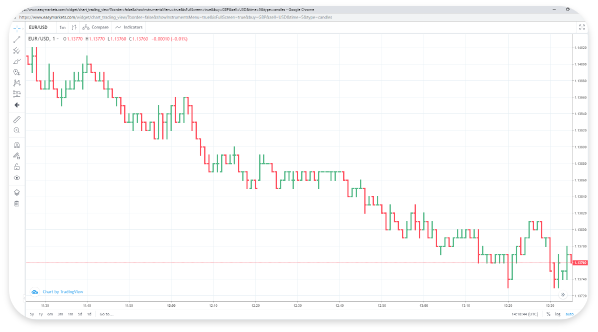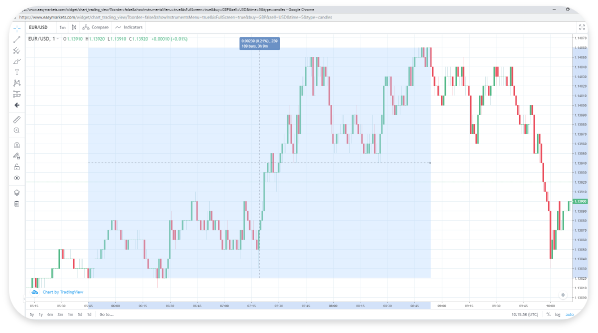How to Use Trading Charts: A Beginner’s Guide

Trading charts are one of the most powerful tools you have as a trader. They help you make sense of what’s happening in the markets by showing how prices have moved over time. With easyMarkets, you have access to a wide range of chart types and analysis tools that can help you identify trends, spot volatility, and better understand price behaviour, no matter your experience level.
So, how can you use these charts effectively?
Getting Started: Choose your chart type
After logging into the easyMarkets platform, click on the chart icon (shaped like a candlestick) to open the chart view. From there, you can select the type of chart you’d like to use. Each chart style offers a slightly different way of viewing price data:
- • Bars (OHLC)
- • Candlesticks
- • Hollow Candlesticks
- • Heikin Ashi
- • Line
- • Area
- • Baseline
On the right-hand side (Y-axis), you’ll see price levels. Along the bottom (X-axis), you’ll see the timeline, whether minutes, hours, days, or longer, depending on the timeframe you choose.

Understanding the different chart types
Bar Charts
Bar charts show the open, high, low, and close of each trading session. You can determine volatility through the height of the bars and the market sentiment through the price range from open to close.

For example:
- • If the closing price is higher than the opening, the bar is green, suggesting bullish sentiment.
- • If the closing price is lower, it will be red, indicating bearish sentiment.
The taller the bar, the more volatile that session was. This type of chart is especially helpful if you’re trying to assess momentum and price pressure over time.

Candlestick Charts
Candlestick charts are one of the most popular ways to view prices as they provide quite a lot of information in a quick and easy manner. The ‘candles’ have a rectangular solid body, showing the range between opening price and closing price. The candles also have vertical lines (or wicks) at the top and bottom that show high to low range.

- • A green candle shows that the closing price was higher than the opening price.
- • A red candle shows that the price closed lower than it opened.
Candlestick patterns can offer clues about potential reversals or continuation of price movements, making them a great choice for technical analysis.

Hollow Candlesticks
Hollow Candlesticks add another layer of detail by comparing not just open and close prices, but also how today’s session compares with the previous day.

Here’s how to read them:
- • Solid green: The price closed higher than the previous close, but lower than today’s open.
- • Hollow green: The close was higher than both the open and the previous close, giving a strong bullish signal.
- • Hollow red: The price closed lower than the previous day, but still above today’s open.
- • Solid red: The price closed below both the previous close and today’s open, giving a strong bearish signal.
This style helps traders better understand short-term price behaviour and momentum shifts.
Heikin Ashi
Similar visually to candlestick charts, the Heikin Ashi use averaged price data, creating smoother charts that help highlight trends, without showing exact open and close prices.
These are useful when you're trying to stay focused on the overall direction of the market rather than the fine details of each session.

Line Charts
Line charts are the simplest and most straightforward option. They connect the closing prices of each session with a single continuous line, showing a clean view of the overall price direction.
They’re great for getting a quick snapshot of market movement without too much detail.

Key Features of Trading Charts
Time Scales
At the top of your chart, you can choose how much data to display, ranging from as little as one minute to hourly, daily, or even longer timeframes. Shorter timeframes can help you monitor quick price movements, while longer ones give a broader view of market trends.

Indicators
Click the ‘Indicators’ tab to access a range of technical tools that can help you analyze price movement.
Some of the most commonly used indicators include:
- • Moving Averages – smooth out price data to reveal trends.
- • Bollinger Bands® – show potential overbought or oversold conditions.
- • RSI (Relative Strength Index) – indicates whether a market is potentially overbought or oversold.
- • MACD (Moving Average Convergence Divergence) – helps identify momentum and possible reversals.
These tools can be used alone or in combination to support your trading decisions.

Symbols Comparison
If you want to analyze more than one instrument at the same time, you can overlay multiple assets on a single chart. For example, you could compare the EUR/USD currency pair with the price of gold (XAU/USD). This can be useful when looking at correlations or differences in performance between markets.

Customization Tools
On the left-hand side of the chart, you have a range of tools to customize your view. Tools may help traders to recognize trends as they draw and mark up the charts.
The Pointer Tool
Use crosshairs, arrows, or points to zoom in for precise data readings.

Trendlines
Trendlines help identify up, down or sideways trends by drawing a line between two highs or two lows. This makes it one of the most popular tools used on charts. Choose from:
- • Basic line
- • Ray (extends to the right)
- • Extended (both directions)
- • Parallel channels (automatically creates a second line)

Drawing Tools
Mark up the chart with freehand drawings or predefined shapes to highlight important zones or price movements.

Text Tool
Add notes, comments, or labels directly onto the chart to keep track of observations or strategy ideas.

Chart Patterns
Use advanced overlays to spot repeating patterns or cycles. These tools can help you analyze longer-term price behaviour or test more advanced strategies. Options include:
- • Elliott Waves
- • Cyclic Lines
- • XABCD Patterns
Over 14 patterns are available, each offering a different view on price action and potential future moves.

Measure Tool
The Measure Tool allows you to highlight a section of the chart and calculate the change in price, time, and the number of bars within that period. This is especially helpful when evaluating the strength and speed of a price move.

Magnet Mode
This tool snaps lines to the nearest open, high, low, or close (OHLC) point – making drawing more accurate.

Other useful features
Stay in drawing mode for quicker markups
Lock all drawings to avoid accidental edits
Hide/show all tools in one click
Object Tree: See a list of all chart elements (lines, annotations, indicators)
Clear/Delete: Remove drawings, indicators, or both
Final thoughts
Trading charts are more than just visuals – they’re decision-making tools. Whether you're tracking short-term price movements or analyzing long-term trends, the easyMarkets platform gives you all the tools you need in one place.
From basic chart views to advanced technical analysis, you can shape the charting experience to match your goals. The more time you spend exploring the features and testing different setups, the more confident you’ll become in making informed, well-timed trading decisions.

Trading charts are one of the most powerful tools you have as a trader. They help you make sense of what’s happening in the markets by showing how prices have moved over time. With easyMarkets, you have access to a wide range of chart types and analysis tools that can help you identify trends, spot volatility, and better understand price behaviour, no matter your experience level.
So, how can you use these charts effectively?














